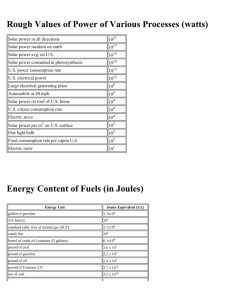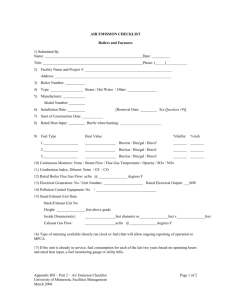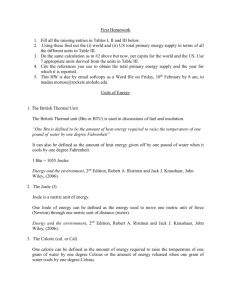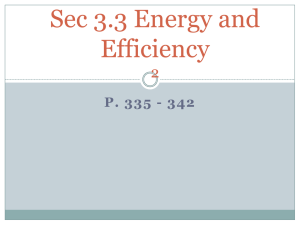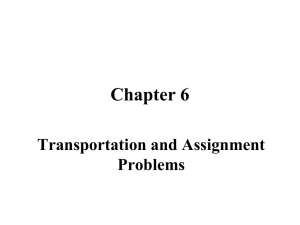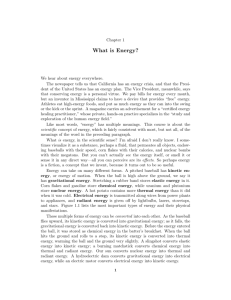Cheatsheet
advertisement
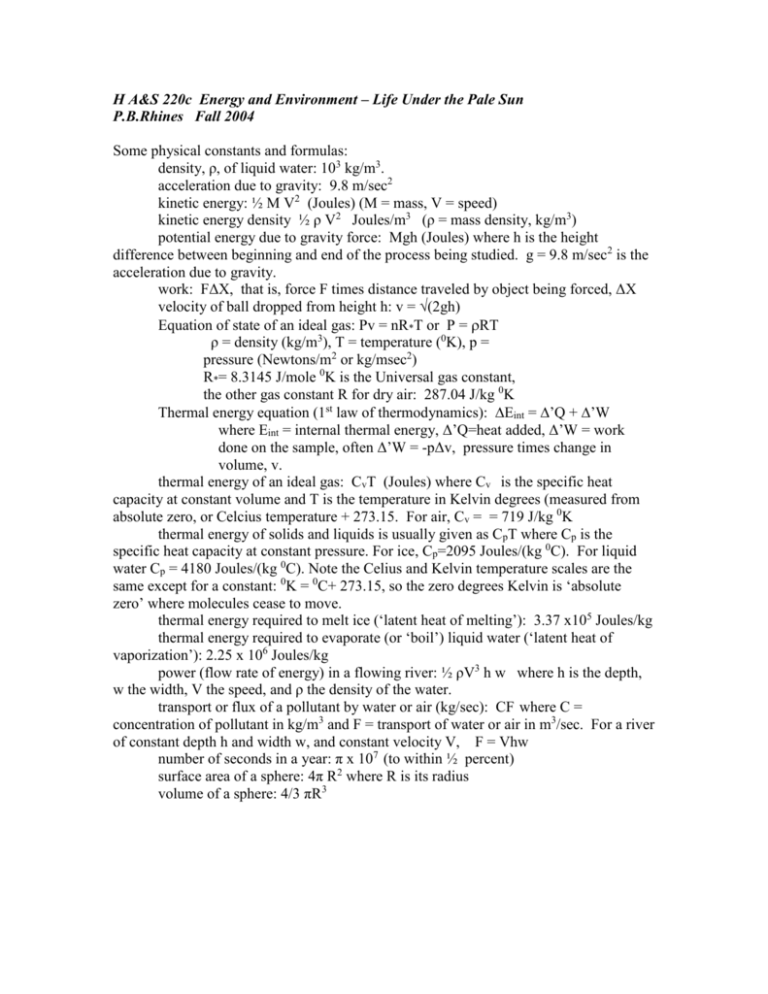
H A&S 220c Energy and Environment – Life Under the Pale Sun P.B.Rhines Fall 2004 Some physical constants and formulas: density, ρ, of liquid water: 103 kg/m3. acceleration due to gravity: 9.8 m/sec2 kinetic energy: ½ M V2 (Joules) (M = mass, V = speed) kinetic energy density ½ ρ V2 Joules/m3 (ρ = mass density, kg/m3) potential energy due to gravity force: Mgh (Joules) where h is the height difference between beginning and end of the process being studied. g = 9.8 m/sec2 is the acceleration due to gravity. work: FΔX, that is, force F times distance traveled by object being forced, ΔX velocity of ball dropped from height h: v = √(2gh) Equation of state of an ideal gas: Pv = nR*T or P = RT ρ = density (kg/m3), T = temperature (0K), p = pressure (Newtons/m2 or kg/msec2) R*= 8.3145 J/mole 0K is the Universal gas constant, the other gas constant R for dry air: 287.04 J/kg 0K Thermal energy equation (1st law of thermodynamics): Eint = ’Q + ’W where Eint = internal thermal energy, Δ’Q=heat added, Δ’W = work done on the sample, often Δ’W = -pΔv, pressure times change in volume, v. thermal energy of an ideal gas: CvT (Joules) where Cv is the specific heat capacity at constant volume and T is the temperature in Kelvin degrees (measured from absolute zero, or Celcius temperature + 273.15. For air, Cv = = 719 J/kg 0K thermal energy of solids and liquids is usually given as CpT where Cp is the specific heat capacity at constant pressure. For ice, Cp=2095 Joules/(kg 0C). For liquid water Cp = 4180 Joules/(kg 0C). Note the Celius and Kelvin temperature scales are the same except for a constant: 0K = 0C+ 273.15, so the zero degrees Kelvin is ‘absolute zero’ where molecules cease to move. thermal energy required to melt ice (‘latent heat of melting’): 3.37 x105 Joules/kg thermal energy required to evaporate (or ‘boil’) liquid water (‘latent heat of vaporization’): 2.25 x 106 Joules/kg power (flow rate of energy) in a flowing river: ½ ρV3 h w where h is the depth, w the width, V the speed, and ρ the density of the water. transport or flux of a pollutant by water or air (kg/sec): CF where C = concentration of pollutant in kg/m3 and F = transport of water or air in m3/sec. For a river of constant depth h and width w, and constant velocity V, F = Vhw number of seconds in a year: π x 107 (to within ½ percent) surface area of a sphere: 4π R2 where R is its radius volume of a sphere: 4/3 πR3 Useful Units and Conversions Prefixes for units in the International System Prefix Symbol Power exa E 1018 peta P 1015 petagram (Pg) quadrillion/billiard tera T 1012 terawatt (TW) trillion/billion giga G 109 gigawatt (GW) billion/milliard mega M 106 megawatt (MW) million kilo k 103 kilogram (kg) hecto h 102 hectoliter (hl) deka da 101 dekagram (dag) deci d 10-1 decimeter (dm) centi c 10-2 centimeter (cm) milli m 10-3 millimeter (mm) micro Example USA/Other quintillion 10-6 nano n 10-9 nanosecond (ns) pico p 10-12 picofarad (pf) femto f 10-15 femtogram (fg) atto a 10-18 Length: 1 meter = 100 cm = 1,000 mm = 3.281 ft = 39.37 inches (in) 1 foot = 12 inches (in) = 30.48 cm = 1/3 yard (yd) 1mile = 5,280 ft = 1.609 km 1 micron ( m)= 10-6 m 1 angström (Å) = 10-10 m 1 nanometer = 10 Å = 10-9m Area: 1 m2 = 10-2 are (a) = 10-4 hectare (hecto-are, ha) = 10.76391 ft2 1 acre = 43,560 ft2 = 4,046.86 m2 = 0.4047 ha 1 ha = 2.4711 acre=104 m2=10-2 km2 Volume: 1 m3 = 106 cm3 = 103 liters (l) = 1.056688×103 quart (qt) = 264.1721 gal (U.S.) 1 liter (l) = 1.056688 quart (qt) = 0.2641721 gal (U.S.) (think of liters as ‘fat quarts’). 1 gallon (U.S.) = 4 qt = 3.785412 l = 0.1336806 ft3 1 barrel (bbl) = 42 gal (U.S.) = 159 l Time: 1 year (yr) = 3.1536×107seconds (s) 1 day (d) = 86,400 s Mass: 1 kg = 2.2046 pounds (lbs) = 10-3 metric ton (tonne) = 1000 grams 1 lb = 0.4535924 kg 1 metric ton = 0.9842 long ton = 1.102311 short ton 1 short ton = 2,000 lbs = 0.9071847 metric ton 1 long ton = 2,240 lbs = 1.016047 metric ton Energy: 1 joule (J) = 0.2390057 calorie (cal) = 9.478172×10-4 British thermal unit (Btu) 1 cal = 4.184 J = 3.965667×10-3 Btu 1 food calorie = 1 Kcal = 103 cal = 4184 J 1 Btu = 1055.056 J = 252.1644 cal = 2.930711×10-4 kilowatt-hour (kWh) 1 kWh = 3.6 megajoule (MJ) = 0.8604207 Mcal = 3412.142 Btu 1 quad = 1015 Btu 1 exajoule = 1018 J (global energy consumption is about 400 exajoules per year Power: 1 W = 1 J/s = 0.9478×10-3 Btu/s = 3.41214 Btu/hr = 1/745.7 HP 1 HP = 745.5 W = 0.706243 Btu/s = 178.1 cal/s Pressure: 1 pascal (Pa) = 1 newton/m2 (N/m2); in more basic units this is 1 kg m-1 sec-2 pressure is force (in newtons) per unit area, and using F=ma the units of pressure are as above, since acceleration is m sec-2, mass is kg. 1 physical atmosphere (atm) = 101325 Pa = 760 mm of mercury (mm Hg) = 14.69. This ‘atmospheric pressure’ is equivalent to the force per unit area of a column of mercury 760 mm high, or a column of water 10.3 meters tall. lb-force/in2 (psi) 1 technical atmosphere (at) = 1 kilogram-force/cm2 (kG/cm2)= 9.806650×104 Pa Energy content of monochromatic visible light Wavelength Color KJ/mole Kcal/mole Photon, eV 700 nm red 171 40.9 1.77 680 nm red(1) 174 41.5 1.81 600 nm yellow 199 47.7 2.07 500 nm blue 239 57.2 2.48 400 nm violet 299 71.5 3.10 (1) This is the wavelength of the red absorption maximum of chlorophyll 1 mole of photons = 6.023×1023 photons (Avogadro number) Speed of light in vacuum = 299,792,458 m/s 1 electronvolt (eV) = 1.60217733×10-19 J 1 mole of eV = 96,499 J Miscellaneous Useful Units and Conversions: Universal gas constant, R = 8.314510 Pa m3 K-1 mol-1 = 82.5 atm cm3 K-1 mol-1 Planck’s constant, h = 6.6×1027 erg s Specific gravity of oil (sgro) = oil density/water density at 600F API gravity (0API)= 141.5/ sgro – 131.5 1 bbl oil = 136 kg for a 35 0API crude oil Energy content of 1 bbl of crude oil = 6.1 GJ (@ 45 MJ/kg) 1 TW = 1TJ/s= 3.1536×1019 J/yr = 5.17×109 bbl oil/yr=5 Gbbl/yr Energy content of 1 m3 of natural gas at standard conditions (14.7 psia and 600F) = 39 MJ Specific energy contents: Energy content of 1 metric ton of natural gas = 49 GJ Energy content of 1 metric ton of crude oil = 45 GJ Energy content of 1 metric ton of coal = 27 GJ (@ 27 MJ/kg) Solar energy fluxes: Solar energy reaching 1 square meter of land in California = 5 kWh/m2/day (that is, 5/24 kilowatts per square meter, or about 417 watts/m2) Solar energy reaching 1ha in the temperate region in one year = 1.4×1010 kcal = 1.63×107 kWh = 58000 GJ/ha/year = 5.8x1013 J/hectare; 1 hectare = 10,000 m2 = 2.471 acres

